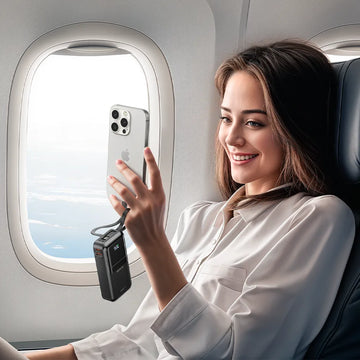Cutting the Cord: The Rise of Wireless Charging in Portable Power Banks
Contents
Power Banks
——————————
In today’s whirlwind of life, we all face a mini existential crisis when our smartphone battery dips below 20%. It’s like watching your life battery level melt away! Our electrical devices have become our loyal sidekicks, and when they run out of juice, it’s like losing your best buddy!

Wireless Charging
——————————
Wireless charging, also called inductive charging, is a type of wireless power transfer. It powers portable electronics by electromagnetic induction.
Wireless charging is also used in vehicles, power tools, electric toothbrushes, and medical devices. The portable accessory can be positioned close to a charging station or inductive pad without requiring precise alignment or direct electrical contact with a dock or plug.

Inductive coupling is used in wireless charging to transfer energy. In the charging station or pad, an induction coil is first subjected to alternating current. Because the amplitude of the electric current varies, the magnetic field produced by the moving electric charge varies in strength. The portable device’s induction coil generates an alternating electric current due to this fluctuating magnetic field, which is subsequently transformed into direct current by passing through a rectifier. Lastly, the direct current supplies working power or charge a battery.
Resonant inductive coupling, which involves adding a capacitor to each induction coil to produce two LC circuits with a certain resonance frequency, allows for greater distances between sender and receiver coils in an inductive charging system. The resonance frequency and the alternating current frequency are matched, and the frequency is selected based on the distance required for maximum efficiency. In order to reduce weight and resistance caused by the skin effect, this resonant system has recently been improved by using a moveable transmission coil and different materials for the receiving coil, such as silver-plated copper or occasionally aluminum.
Inductive charging has a wide range of applications. Low-power applications typically support small consumer electronics like smartphones, handheld devices, and some computers, which usually charge at power levels below 100 watts. In contrast, high-power inductive charging involves charging batteries at levels above 1 kilowatt.
The most notable application for high-power inductive charging is electric vehicles, which offer a convenient, automated alternative to traditional plug-in charging. Power levels for these systems can vary from around 1 kilowatt to 300 kilowatts or more. All high-power inductive charging systems utilize resonated primary and secondary coils.
The efficiency of the system can be increased by using short wave frequencies, although long-distance signal transmission may result as well. High power levels raise concerns about radio frequency interference and electromagnetic compatibility.
Advantages of Wireless Charging
——————————
Safer Connections: Reduced chance of electrical problems like short circuits brought on by insulation breakdown, particularly in areas where connections are made or severed regularly. Overheating is less likely with wireless charging devices since they frequently come with integrated safety features like temperature control and overcharge protection.
Improved Convenience: More frequent charging events and a longer driving range are made by automated high-power inductive charging of electric vehicles. Device powering is finished easier via wireless charging, which eliminates the need for cords.
Low Infection Risk: By transmitting electricity through a magnetic field that travels through the skin, implanted medical devices can avoid the infection dangers that come with cables piercing the skin.
Durability: Without the need to constantly plug and unplug the device, both charging ports and cables are less likely to wear and tear. Inductive charging systems can be operated automatically without dependence on people to plug and unplug.
Larger Compatibility: Wireless chargers are compatible with multiple devices, including smartphones, smartwatches, and earbuds, simplifying the whole charging process.
Great Design: Wireless chargers look sleek and stylish while blending in perfectly with business or other settings.
Multi-device Charging: For users who own many devices, wireless charging power banks offer the opportunity to charge multiple devices at once.
Future-Proofing: Wireless charging is a progressive option for powering your essentials since it becomes more popular as technology develops.

Qi Standard
——————————
The Wireless Power Consortium develops the Qi standard. As a universal, open standard Qi-enabled device is able to connect to Qi chargers from any manufacturer.

Qi was initially launched in 2008 and had been integrated into over 200 smartphones, tablets, and other devices by 2017. As of December 2023, 351 manufacturers, including Apple, Asus, Google, Huawei, LG Electronics, Samsung, Xiaomi, and Sony, are utilizing the standard.

In January 2023, the Wireless Power Consortium introduced the Qi2 standard. Launched on April 19, 2023, it enhances the previous Qi standard by incorporating magnetic attachment and alignment features inspired by Apple's MagSafe technology.
MOKiN Portable Power Banks
——————————
MOKiN incorporates advanced technology into its power banks to enhance charging, increase battery life, and safeguard your devices.
These power banks support magnetic charging and are essential tools for electronic fans, and they are more than just accessories for charging gadgets. Explore to discover fashionable and useful power banks that will keep you energized whenever and whenever.

The MOKiN 65W power bank is portable and ideal for work and play. In terms of capacity, it is enough to power your devices for outdoor activities and business travel. Adopted with versatile ports and cables available, the MOKiN can charge up to four devices at the same time.

It’s one of the few power banks on the market that features Micro USB, USB-A, and USB-C ports, all capable of delivering output power. Plus, there are still plenty of USB-A and USB-C charging cables available.
Conclusion
——————————
Thanks to several ongoing advancements aimed at enhancing efficiency, speed, and range, wireless charging is set for an exciting future.
Wireless charging using magnetic induction could change the way power is transmitted. Daily usage is simple cause it does not need cables. As technology progresses, we can expect ongoing enhancements in wireless charging systems, leading to more efficient solutions that will enhance our digital experiences.
YOU MAY ALSO LIKE
——————————
Revolutionizing Charging: The Era of Smart Power Banks --- Your Perfect On-the-Go Partner
Revolutionizing Charging: The Age of Intelligent Power Banks

MOKiN 13-IN-1 USB-C Laptop Charging Station with 2.26-inch LCD Smart Display








